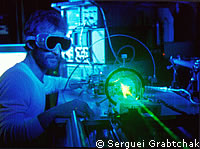European scientists make breakthrough in nuclear waste disposal
A consortium of UK and German researchers has successfully transformed the radioactive isotope Iodine-129, a major waste product from nuclear power generation, into the safer isotope Iodine-128, using laboratory lasers. The scientists from the University of Strathclyde, Imperial College London, Rutherford Appleton Laboratory, ITU Karlsruhe and the University of Jena are the first to ever successfully transmute an isotope, and have published their findings in the Journal of Physics. Iodine-129 has a half-life (the amount of time it takes for half the atoms in a given sample to decay) of 15.7 million years, so currently it is encased in glass and buried deep underground. Iodine-128, however, has a half-life of just 25 minutes and can be safely handled and disposed of in under an hour. Professor Ken Ledingham, from the University of Strathclyde, said: 'The discovery [...] shows for the first time that we can transmute radioactive isotopes using lasers. Now we need to scale up our methods so that we can deal with the sort of volumes likely to be produced by the nuclear power industry in the future. Using lasers is a relatively cheap and very efficient way of disposing of nuclear waste.' The consortium also believes that their method will facilitate production of the isotopes needed for PET scanners, used in hospitals and research. Currently these isotopes are created in huge machines called cyclotrons, but the team believe that manufacture using lasers will be a practical reality within five years.
Kraje
Germany, United Kingdom



